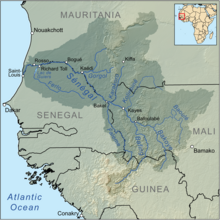
Back Sénégalrivier Afrikaans نهر السنغال Arabic نهر السنجال ARZ Ríu Senegal AST Сенегал (йылға) Bashkir Сенегал (рака) Byelorussian Сэнэгал (рака) BE-X-OLD Сенегал (река) Bulgarian सेनेगल नदी Bihari সেনেগাল নদী Bengali/Bangla
| Senegal River | |
|---|---|
 Boats on the Senegal River, on the border between Senegal and Mauritania | |
 Map of the Senegal River drainage basin. | |
| Location | |
| Country | Senegal, Mauritania, Mali |
| Physical characteristics | |
| Source | Bakoy River |
| • location | Menien-Koma, Guinea |
| • coordinates | 11°50′N 9°45′W / 11.833°N 9.750°W |
| • elevation | 760 m (2,490 ft) |
| 2nd source | Bafing River |
| • location | Foranruel, Guinea |
| • coordinates | 10°23′42″N 12°08′06″W / 10.395°N 12.135°W |
| • elevation | 750 m (2,460 ft) |
| Source confluence | |
| • location | Bafoulabé, Mali |
| • coordinates | 13°48′47″N 10°49′41″W / 13.813°N 10.828°W |
| • elevation | 83 m (272 ft) |
| Mouth | Atlantic Ocean |
• location | Saint-Louis, Senegal |
• coordinates | 15°56′17″N 16°30′29″W / 15.938°N 16.508°W |
• elevation | 0 m (0 ft) |
| Length | 1,086 km (675 mi) |
| Basin size | 337,000 km2 (130,000 sq mi) |
| Discharge | |
| • average | 680 m3/s (24,000 cu ft/s) |
Senegal River at Dagana, Senegal

The Senegal River (Arabic: نَهر السنغَال, romanized: Nehr es-Sinigâl, French: Fleuve Sénégal, Wolof: Dexug Senegaal) is a 1086-kilometre-long (675 mi) river in West Africa; much of its length marks part of the border between Senegal and Mauritania. It has a drainage basin of 270000 km2 (100000 sq mi), a mean flow of 680 m3/s (24,000 cu ft/s), and an annual discharge of 21.5 km3 (5.2 cu mi). Important tributaries are the Falémé River, Karakoro River, and the Gorgol River. The river divides into two branches once it passes Kaédi The left branch, called the Doué, runs parallel to the main river to the north. After 200 km (120 mi) the two branches rejoin a few kilometers downstream of Podor.
In 1972 Mali, Mauritania and Senegal founded the Organisation pour la mise en valeur du fleuve Sénégal (OMVS) to manage the river basin. Guinea joined in 2005. As of 2012[update], only very limited use was made of the river for the transportation of goods and passengers. The OMVS have looked at the feasibility of creating a navigable channel 55 m (180 ft) in width between the small town of Ambidédi in Mali and Saint-Louis, a distance of 905 km (562 mi). It would give landlocked Mali a direct route to the Atlantic Ocean.
The aquatic fauna in the Senegal River basin is closely associated with that of the Gambia River basin, and the two are usually combined under a single ecoregion known as the Senegal-Gambia Catchments. Only three species of frogs and one fish are endemic to this ecoregion.
The river has two large dams along its course, the Manantali Dam in Mali and the Maka-Diama Dam downstream on the Mauritania-Senegal border. In between is the Félou Hydroelectric Plant, built in 1927, but replaced in 2014. The construction of the Gouina Hydroelectric Plant upstream of Felou at Gouina Falls began in 2013.
- ^ Hydrographic data for Dagana, Senegal 1903-1974, Unesco International Hydrological Programme, retrieved 24 May 2012.
© MMXXIII Rich X Search. We shall prevail. All rights reserved. Rich X Search